Search
- Page Path
-
- HOME
- Search
- Review Article
- Nephrology (Genitourinary)
- Kidney complications associated with COVID-19 infection and vaccination in children and adolescents: a brief review
- Hee Sun Baek, Min Hyun Cho
- Clin Exp Pediatr. 2023;66(10):424-431. Published online June 28, 2023
-
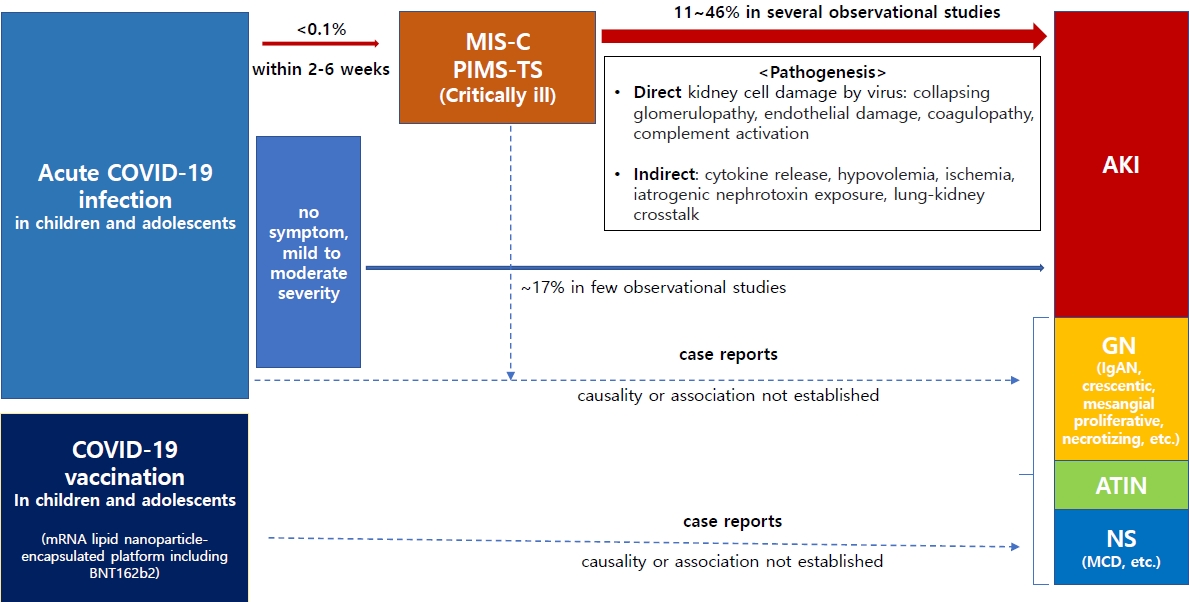
Several observational studies have shown that acute kidney injury affects up to 46% of children and adolescents who develop severe postinflammatory responses, such as multisystem inflammatory syndrome in childhood, due to coronavirus disease 2019 (COVID-19). Although causality has not been established, some cases of glomerulopathy or nephrotic syndrome occurring after COVID-19 infection or vaccination have been reported. Therefore, kidney complications associated with these conditions in children and adolescents warrant attention.
- Original Article
- Pulmonology
- Predictors of high-flow nasal cannula failure in pediatric patients with acute respiratory distress
- Kantara Saelim, Busawan Thirapaleka, Kanokpan Ruangnapa, Pharsai Prasertsan, Wanaporn Anuntaseree
- Clin Exp Pediatr. 2022;65(12):595-601. Published online November 1, 2022
-
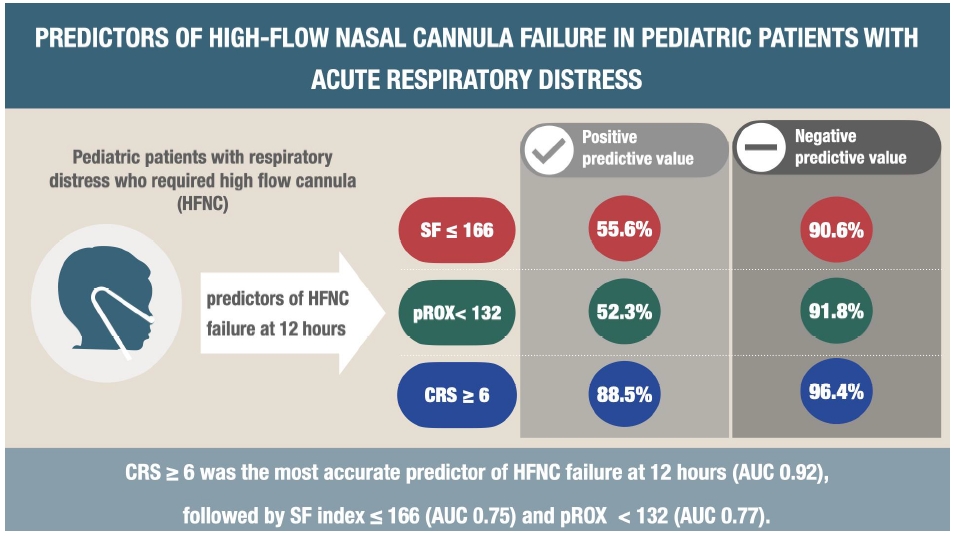
SpO2/FiO2 ratio ≤166, pediatric respiratory rate-oxygenation index <132, and clinical respiratory score ≥6 at 12 hours after high-flow nasal cannula (HFNC) initiation were useful bedside predictors for HFNC failure in pediatric patients.
- Infection
- Febrile urinary tract infection in children: changes in epidemiology, etiology, and antibiotic resistance patterns over a decade
- Woosuck Suh, Bi Na Kim, Hyun Mi Kang, Eun Ae Yang, Jung-Woo Rhim, Kyung-Yil Lee
- Clin Exp Pediatr. 2021;64(6):293-300. Published online October 14, 2020
-
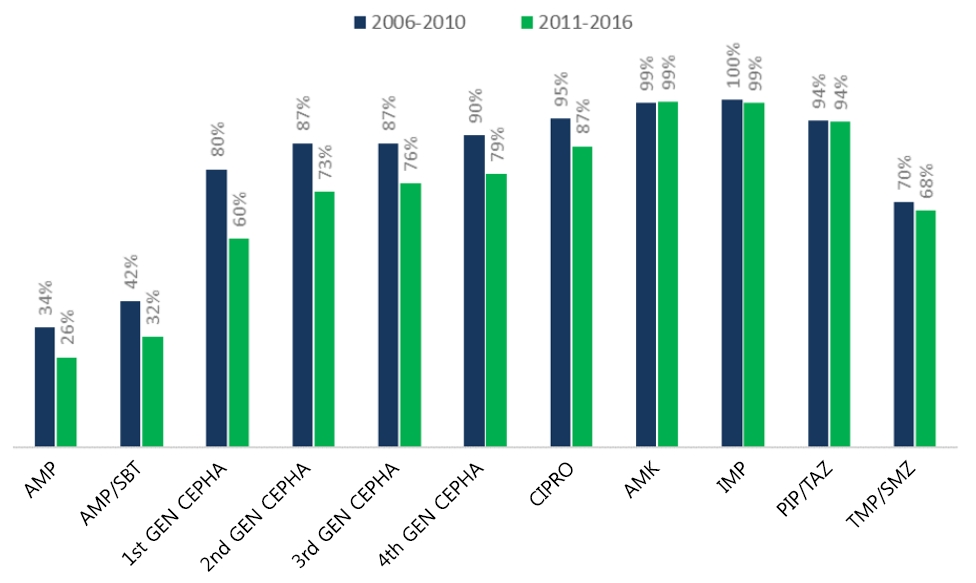
Question: How has the antibiotic susceptibility of urinary pathogens changed and what does it imply?
Finding: A yearly increase in multidrug-resistant and extended-spectrum β-lactamase (ESBL)–producing pathogens was observed. A higher recurrence rate was observed in cases of febrile urinary tract infection caused by ESBL producers in patients with underlying vesicoureteral reflux (VUR).
Meaning: The initial empirical antibiotic should reflect the changing susceptibility patterns and underlying VUR status.
- Review Article
- Neurology
- Myelin oligodendrocyte glycoprotein antibody-associated disorders: clinical spectrum, diagnostic evaluation, and treatment options
- Yun-Jin Lee, Sang Ook Nam, Ara Ko, JuHyun Kong, Shin Yun Byun
- Clin Exp Pediatr. 2021;64(3):103-110. Published online May 14, 2020
-
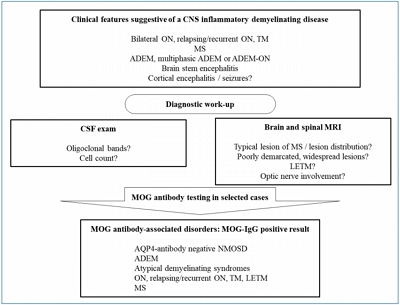
MOG antibody-associated disorder exhibits different pathophysiological and phenotypic findings than both aquaporin-4 antibody-associated neuromyelitis optica spectrum disorder and typical MS. MOG-antibody is of particular interest in pediatric patients with clinical or radiological non-MS typical findings. MOG-antibody was included in a diagnostic algorithm for children recommending for the first time a standardized use in clinical practice except in cases of typical MS.
- Original Article
- Nephrology (Genitourinary)
- Variation in clinical usefulness of biomarkers of acute kidney injury in young children undergoing cardiac surgery
- Hee Sun Baek, Youngok Lee, Hea Min Jang, Joonyong Cho, Myung Chul Hyun, Yeo Hyang Kim, Su-Kyeong Hwang, Min Hyun Cho
- Clin Exp Pediatr. 2020;63(4):151-156. Published online February 5, 2020
-
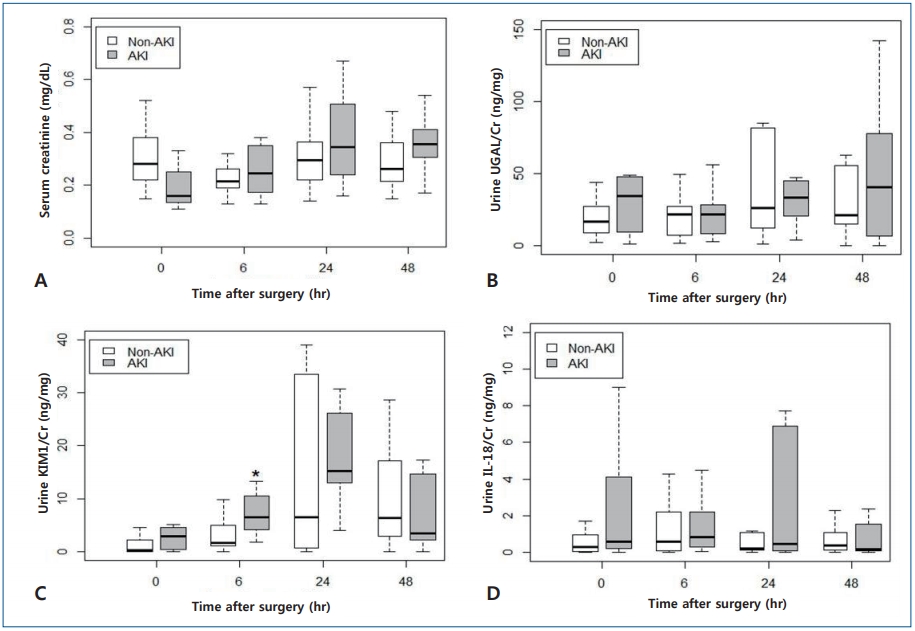
Question: Can clinical usefulness of biomarkers of acute kidney injury vary on the clinical circumstances?
Finding: In young children undergoing cardiac surgery, urine KIM-1/Cr level peaked at 24 hours with significant difference from baseline level and was significantly higher at 6 hours in the AKI group. However, urine NGAL/Cr and IL-18/Cr levels showed no specific trend with time for 48 hours after cardiac surgery.
Meaning: Urine KIM-1/Cr concentration could be considered a good biomarker for early AKI prediction after open cardiac surgery in young children.
- Review Article
- Nephrology (Genitourinary)
- Acute kidney injury and continuous renal replacement therapy in children; what pediatricians need to know
- Myung Hyun Cho, Hee Gyung Kang
- Clin Exp Pediatr. 2018;61(11):339-347. Published online October 23, 2018
-
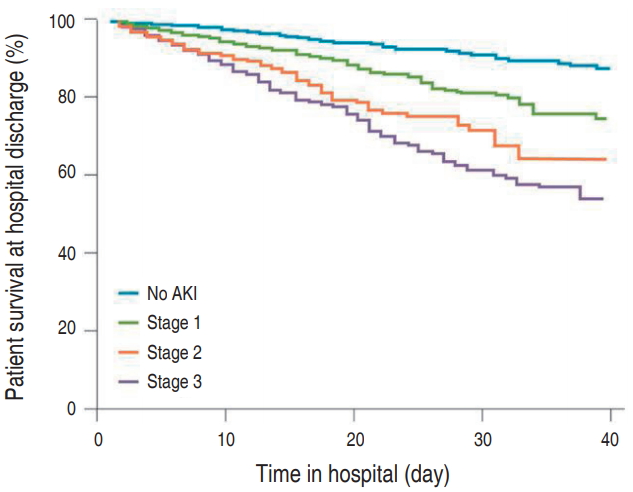
Acute kidney injury (AKI) is characterized by abrupt deterioration of renal function, and its diagnosis relies on creatinine measurements and urine output. AKI is associated with higher morbidity and mortality, and is a risk factor for development of chronic kidney disease. There is no proven medication for AKI. Therefore, prevention and early detection are important. Physicians should be aware of...
- Case Report
- Neurology
- A long-term subacute sclerosing panencephalitis survivor treated with intraventricular interferon-alpha for 13 years
- Minsun Kwak, Hye-Ryun Yeh, Mi-Sun Yum, Hyun-Jin Kim, Su Jeong You, Tae-Sung Ko
- Clin Exp Pediatr. 2019;62(3):108-112. Published online September 18, 2018
-

Subacute sclerosing panencephalitis (SSPE) is a rare, progressive, and fatal central nervous system disorder resulting from persistent measles virus infection. Long-term data are scarce, with a maximum follow-up period of 10 years. Interferon-alpha (IFN-α) is a protein that exerts its antiviral activity via enhancement of cellular immune response and is reported to be an effective drug for the treatment of...
- Original Article
- Nephrology (Genitourinary)
- Acute kidney injury in pediatric patients with rhabdomyolysis
- Young Shin Lim, Heeyeon Cho, Sang Taek Lee, Yeonhee Lee
- Clin Exp Pediatr. 2018;61(3):95-100. Published online March 19, 2018
-
Purpose This study aimed to evaluate the clinical findings in pediatric rhabdomyolysis and the predictive factors for acute kidney injury (AKI) in Korean children.
Methods Medical records of 39 Korean children, who were newly diagnosed with rhabdomyolysis from January 2008 to December 2015, were retrospectively analyzed. The diagnosis was made from the medical history, elevated serum creatinine kinase level >1,000 IU/L, and plasma...
- Neurology
- Serum neuron specific enolase is increased in pediatric acute encephalitis syndrome
- Dian Pratamastuti, Prastiya Indra Gunawan, Darto Saharso
- Clin Exp Pediatr. 2017;60(9):302-306. Published online September 21, 2017
-
Purpose This study aimed to investigate whether serum neuron-specific enolase (NSE) was expressed in acute encephalitis syndrome (AES) that causes neuronal damage in children.
Methods This prospective observational study was conducted in the pediatric neurology ward of Soetomo Hospital. Cases of AES with ages ranging from 1 month to 12 years were included. Cases that were categorized as simple and complex febrile seizures...
- Review Article
- Oncology
- Prognostic factors and treatment of pediatric acute lymphoblastic leukemia
- Jae Wook Lee, Bin Cho
- Clin Exp Pediatr. 2017;60(5):129-137. Published online May 31, 2017
-
The event-free survival (EFS) for pediatric acute lymphoblastic leukemia (ALL) has shown remarkable improvement in the past several decades. In Korea also, a recent study showed 10-year EFS of 78.5%. Much of the improved outcome for pediatric ALL stems from the accurate identification of prognostic factors, the designation of risk group based on these factors, and treatment of appropriate duration...
- Case Report
- Neurology
- Concurrency of Guillain-Barre syndrome and acute transverse myelitis: a case report and review of literature
- Orkun Tolunay, Tamer Çelik, Ümit Çelik, Mustafa Kömür, Zeynep Tanyeli, Abdurrahman Sönmezler
- Clin Exp Pediatr. 2016;59(Suppl 1):S161-S164. Published online November 30, 2016
-
Guillain-Barré syndrome and acute transverse myelitis manifest as demyelinating diseases of the peripheral and central nervous system. Concurrency of these two disorders is rarely documented in literature. A 4-year-old girl presenting with cough, fever, and an impaired walking ability was admitted to hospital. She had no previous complaints in her medical history. A physical examination revealed lack of muscle strength...
- Original Article
- Hematology
- Clinical course and prognostic factors of childhood immune thrombocytopenia: single center experience of 10 years
- Jae Yeob Jung, A Rum O, Je Keong Kim, Meerim Park
- Clin Exp Pediatr. 2016;59(8):335-340. Published online August 24, 2016
-
Purpose This study aimed to evaluate the clinical course of childhood immune thrombocytopenia (ITP) and to assess the risk factors for developing chronic ITP.
Methods The records of 64 children diagnosed with ITP from November 2005 and December 2014 at single center were retrospectively analyzed.
Results The median age at diagnosis and the median platelet count were 1 year (range, 1 month to 15 years)...
- Neurology
- Clinical importance of F-waves as a prognostic factor in Guillain-Barré syndrome in children
- Eung-Bin Lee, Yun Young Lee, Jae Min Lee, Su Min Son, Su-Kyeong Hwang, Soonhak Kwon, Sae Yoon Kim
- Clin Exp Pediatr. 2016;59(6):271-275. Published online June 30, 2016
-
Purpose A limited number of studies have examined the link between F-wave abnormalities and clinical presentation in pediatric Guillain-Barré syndrome (GBS). Therefore, this study examined the importance of F-wave abnormalities as a prognostic factor in pediatric GBS patients.
Methods The records and electrodiagnostic studies (EDS) of 70 GBS patients were retrospectively evaluated, and divided into 2 groups according to the results of EDS....
- Nephrology (Genitourinary)
- Acute tubular necrosis as a part of vancomycin induced drug rash with eosinophilia and systemic symptoms syndrome with coincident postinfectious glomerulonephritis
- Kyung Min Kim, Kyoung Sung, Hea Koung Yang, Seong Heon Kim, Hye Young Kim, Gil Ho Ban, Su Eun Park, Hyoung Doo Lee, Su Young Kim
- Clin Exp Pediatr. 2016;59(3):145-148. Published online March 31, 2016
-
Drug rash with eosinophilia and systemic symptoms (DRESS) syndrome is a rare and potentially fatal condition characterized by skin rash, fever, eosinophilia, and multiorgan involvement. Various drugs may be associated with this syndrome including carbamazepine, allopurinol, and sulfasalazine. Renal involvement in DRESS syndrome most commonly presents as acute kidney injury due to interstitial nephritis. An 11-year-old boy was referred to...
- Case Report
- Urosepsis and postrenal acute renal failure in a neonate following circumcision with Plastibell device
- Meena Kalyanaraman, Derrick McQueen, Joseph Sykes, Tej Phatak, Farhaan Malik, Preethi S. Raghava
- Clin Exp Pediatr. 2015;58(4):154-157. Published online April 22, 2015
-
Plastibell is one of the three most common devices used for neonatal circumcision in the United States, with a complication rate as low as 1.8%. The Plastibell circumcision device is commonly used under local anesthesia for religious circumcision in male neonates, because of cosmetic reasons and ease of use. Occasionally, instead of falling off, the device may get buried under...
- Original Article
- A comparison of the efficacy of amoxicillin and nasal irrigation in treatment of acute sinusitis in children
- Abolfazl Khoshdel, Gholam Reza Panahande, Mohamad Kazem Noorbakhsh, Mohamad Reza Malek Ahmadi, Masoud Lotfizadeh, Neda Parvin
- Clin Exp Pediatr. 2014;57(11):479-483. Published online November 30, 2014
-
Purpose The efficacy of antibiotic therapy for acute sinusitis is controversial. This study aimed to compare the efficacies of amoxicillin with nasal irrigation and nasal irrigation alone for acute sinusitis in children.
Methods This randomized, double-blind, controlled study included 80 children aged 4-15 years with a clinical presentation of acute sinusitis. Patients were randomly assigned to receive either amoxicillin (80 mg/kg/day) in 3...
- Clinical outcome of acute necrotizing encephalopathy in related to involving the brain stem of single institution in Korea
- Cha Gon Lee, Ji Hye Kim, Munhyang Lee, Jeehun Lee
- Clin Exp Pediatr. 2014;57(6):264-270. Published online June 30, 2014
-
Purpose Acute necrotizing encephalopathy (ANE) is a fulminant disease of the brain characterized by bilateral thalamic lesions, and is prevalent among children in East Asia. The prognosis of ANE is usually poor with a high mortality rate and neurological sequelae. This study aimed to delineate the clinical characteristics and prognostic factors of ANE.
Methods We retrospectively analyzed clinical data of 399 pediatric patients...
- Utility of a multiplex reverse transcriptase-polymerase chain reaction assay (HemaVision) in the evaluation of genetic abnormalities in Korean children with acute leukemia: a single institution study
- Hye-Jin Kim, Hyun Jin Oh, Jae Wook Lee, Pil-Sang Jang, Nack-Gyun Chung, Myungshin Kim, Jihyang Lim, Bin Cho, Hack-Ki Kim
- Clin Exp Pediatr. 2013;56(6):247-253. Published online June 21, 2013
-
Purpose In children with acute leukemia, bone marrow genetic abnormalities (GA) have prognostic significance, and may be the basis for minimal residual disease monitoring. Since April 2007, we have used a multiplex reverse transcriptase-polymerase chain reaction tool (HemaVision) to detect of GA.
Methods In this study, we reviewed the results of HemaVision screening in 270 children with acute leukemia, newly diagnosed at The...
- Case Report
- Liver transplantation in a child with acute liver failure resulting from drug rash with eosinophilia and systemic symptoms syndrome
- Seung Min Song, Min Sung Cho, Seak Hee Oh, Kyung Mo Kim, Young Seo Park, Dae Yeon Kim, Sung Gyu Lee
- Clin Exp Pediatr. 2013;56(5):224-226. Published online May 28, 2013
-
Drug rash with eosinophilia and systemic symptoms (DRESS) syndrome is characterized by a severe idiosyncratic reaction including rash and fever, often with associated hepatitis, arthralgias, lymph node enlargement, or hematologic abnormalities. The mortality rate is approximately 10%, primarily owing to liver failure with massive or multiple disseminated focal necrosis. Here, we report a case of a 14-year-old girl treated with...
- Original Article
- Serum levels of interleukin-6 and interleukin-8 as diagnostic markers of acute pyelonephritis in children
- Abolfazl Mahyar, Parviz Ayazi, Mohammad Reza Maleki, Mohammad Mahdi Daneshi-Kohan, Hamid Reza Sarokhani, Hassan Jahani Hashemi, Mousa Talebi-Bakhshayesh
- Clin Exp Pediatr. 2013;56(5):218-223. Published online May 28, 2013
-
Purpose Early diagnosis and treatment of acute pyelonephritis in children is of special importance in order to prevent serious complications. This study was conducted to determine the diagnostic value of serum interleukin (IL)-6 and IL-8 in children with acute pyelonephritis.
Methods Eighty-seven patients between 1 month to 12 years old with urinary tract infection (UTI) were divided into 2 groups based on the...
- Vascular endothelial dysfunction after anthracyclines treatment in children with acute lymphoblastic leukemia
- Woo Jung Jang, Duk Yong Choi, In-Sang Jeon
- Clin Exp Pediatr. 2013;56(3):130-134. Published online March 18, 2013
-
Purpose Anthracyclines have been utilized in the treatment of children with acute lymphoblastic leukemia (ALL). Recent studies have shown that anthracyclines may induce toxicity in the vascular endothelium. This study was performed using brachial artery reactivity (BAR) to evaluate vascular endothelial function in ALL patients who were treated with anthracycline chemotherapy.
Methods We included 21 children with ALL who received anthracycline chemotherapy and...
- Case Report
- A case of acute necrotizing encephalopathy associated with parainfluenza virus infection
- Yoo-Na Kim, Su Jeong You
- Clin Exp Pediatr. 2012;55(4):147-150. Published online April 30, 2012
-
Acute necrotizing encephalopathy (ANE) may be suspected when a young child presents with abrupt onset of altered mental status, seizures, or both. Definitive clinical diagnosis is based on magnetic resonance imaging (MRI) results. ANE is associated with influenza virus infections. Preliminary data suggests that up to 25% of ANE patients die, and up to 25% of ANE survivors develop substantial...
- Original Article
- Evaluation of changes in random blood glucose and body mass index during and after completion of chemotherapy in children with acute lymphoblastic leukemia
- Kyong-Won Bang, Soo Young Seo, Jae Wook Lee, Pil-Sang Jang, Min Ho Jung, Nack-Gyun Chung, Bin Cho, Dae-Chul Jeong, Byung Kyu Suh, Hack-Ki Kim
- Clin Exp Pediatr. 2012;55(4):121-127. Published online April 30, 2012
-
Purpose Improved survival of patients with childhood acute lymphoblastic leukemia (ALL) has drawn attention to the potential for late consequences of previous treatments among survivors, including metabolic syndrome. In this study, we evaluated changes in 3 parameters, namely, random blood glucose, body mass index (BMI), and Z score for BMI (Z-BMI), in children with ALL during chemotherapy and after completion of...
- Outcome of allogeneic hematopoietic stem cell transplantation for childhood acute lymphoblastic leukemia in second complete remission: a single institution study
- Eun-Jung Lee, Ji Yoon Han, Jae Wook Lee, Pil-Sang Jang, Nack-Gyun Chung, Dae-Chul Jeong, Bin Cho, Hack-Ki Kim
- Clin Exp Pediatr. 2012;55(3):100-106. Published online March 16, 2012
-
Purpose The survival rate for childhood acute lymphoblastic leukemia (ALL) has improved significantly. However, overall prognosis for the 20 to 25% of patients who relapse is poor, and allogeneic hematopoietic stem cell transplantation (HSCT) offers the best chance for cure. In this study, we identified significant prognostic variables by analyzing the outcomes of allogeneic HSCT in ALL patients in second complete...
- Review Article
- Epidemiology of astrovirus infection in children
- Hye Sook Jeong, Ahyong Jeong, Doo-Sung Cheon
- Clin Exp Pediatr. 2012;55(3):77-82. Published online March 16, 2012
-
Human astrovirus (HAstV) is a major cause of acute diarrhea among children, resulting in outbreaks of diarrhea and occasionally hospitalization. Improved surveillance and application of sensitive molecular diagnostics have further defined the impact of HAstV infections in children. These studies have shown that HAstV infections are clinically milder (diarrhea, vomiting, fever) than infections with other enteric agents. Among the 8...
- Case Report
- An adverse event following 2009 H1N1 influenza vaccination: a case of acute disseminated encephalomyelitis
- Sang Teak Lee, Young June Choe, Won Jin Moon, Jin Woo Choi, Ran Lee
- Clin Exp Pediatr. 2011;54(10):422-424. Published online October 31, 2011
-
Acute disseminated encephalomyelitis (ADEM) is an inflammatory demyelinating disease of the central nervous system that typically follows an infection or vaccination and has a favorable long-term prognosis. We describe the first reported case of ADEM after vaccination against novel influenza A (H1N1). A previously healthy 34-month-old boy who developed ADEM presented with a seizure and left-sided weakness 5 days after...
- Review Article
- Acute disseminated encephalomyelitis in children: differential diagnosis from multiple sclerosis on the basis of clinical course
- Yun Jin Lee
- Clin Exp Pediatr. 2011;54(6):234-240. Published online June 30, 2011
-
Acute disseminated encephalomyelitis (ADEM) is a demyelinating disease of the central nervous system (CNS) that typically presents as a monophasic disorder associated with multifocal neurologic symptoms and encephalopathy. ADEM is considered an autoimmune disorder that is triggered by an environmental stimulus in genetically susceptible individuals. The diagnosis of ADEM is based on clinical and radiological features. Most children with ADEM...
- Original Article
- Discordant findings on dimercaptosuccinic acid scintigraphy in children with multi-detector row computed tomography-proven acute pyelonephritis
- Jeongmin Lee, Duck Geun Kwon, Se Jin Park, Ki-Soo Pai
- Clin Exp Pediatr. 2011;54(5):212-218. Published online May 31, 2011
-
Purpose The diagnosis of acute pyelonephritis (APN) is often difficult, as its clinical and biological manifestations are non-specific in children. If not treated quickly and adequately, however, APN may cause irreversible renal damage, possibly leading to hypertension and chronic renal failure. We were suspecting the diagnostic value of 99mTc-dimercaptosuccinic acid (DMSA) scan by experiences and so compared the results of DMSA...
- Review Article
- Philadelphia chromosome-positive acute lymphoblastic leukemia in childhood
- Hong Hoe Koo
- Clin Exp Pediatr. 2011;54(3):106-110. Published online March 31, 2011
-
In pediatric patients with acute lymphoblastic leukemia (ALL), the Philadelphia chromosome translocation is uncommon, with a frequency of less than 5%. However, it is classified as a high or very high risk, and only 20-30% of Philadelphia chromosome-positive (Ph+) children with ALL are cured with chemotherapy alone. Allogeneic hematopoietic stem cell transplantation from a closely matched donor cures 60% of...
- Recent advances in the diagnosis and management of childhood acute promyelocytic leukemia
- Eun Sun Yoo
- Clin Exp Pediatr. 2011;54(3):95-105. Published online March 31, 2011
-
Since the successful introduction of all-trans-retinoic acid (ATRA) and its combination with anthracycline-containing chemotherapy, the prognosis for acute promyelocytic leukemia (APL) has markedly improved. With ATRA and anthracycline-based-chemotherapy, the complete remission rate is greater than 90%, and the long-term survival rate is 70-89%. Moreover, arsenic trioxide (ATO), which was introduced for APL treatment in 1994, resulted in excellent remission rates...
-

-
-

-

-
Impact Factor4.2
-
6.52022CiteScore92nd percentilePowered by







